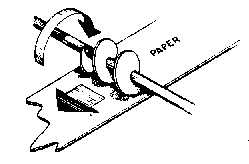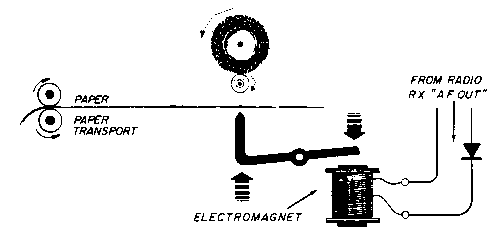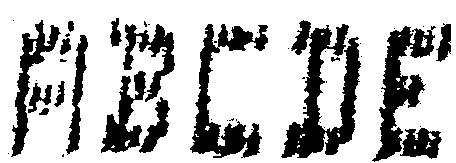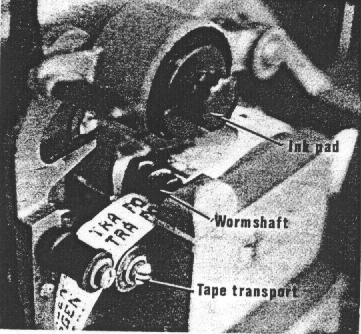


This has been cut from Ham Radio, December 1979. Click here to see the article.
| Imagine a fast turning worm shaft above a relatively slow-moving paper tape: |  |
| The thread on this worm shaft is kept wet with printing ink: |  |
| Under the paper is a mechanism that taps the paper against tha worm shaft by means of an electromagnet: |  |
| What is printed on the paper depends upon the rhythm and the length of time the elactromagnet is actuated. For example if the paper is just tapped. one gets: |  |
| What you see are the little dots where the paper touched the fast-turning worm shaft. If the thread sweeps fast over the paper and if the electromagnet pushes a bit longer, a little line is printed: |  |
| If the tape is tapped in rhythm with the revolutions of the worm shaft, a sequence of little dots is printed: |  |
Thus, all sorts of simple images can be written: for instance: all the characters of the alphabet:

| Or if necessary, the characters of anybody else's alphabet. such as Greek, Arabic or Chinese: |  |
| What happens if the worm-shaft speed is not quite correct Nothing serious: the lines of the Hell text threaten to run off the paper tape: |  |
| This provides a simple method for determining the correct speed If, for example, the lines show a tendency to drop. the motor speed must be increased until the lines run straight again. But whatever happens, the text remains legible. |  |
| Hell writing. This enlargement shows how each character takes the space of seven image lines. As a result of the relatively slow moving tape, the characters hang slightly over. |  |
| Printing mechanism of the Hellschreiber. The ink pad (felt roll) has been lifted to show the worm shaft. The paper tape is slowly moved by the transport capstan. The electromagnet (not visible) taps the paper tape from below against the fast turning worm shaft. . |  |